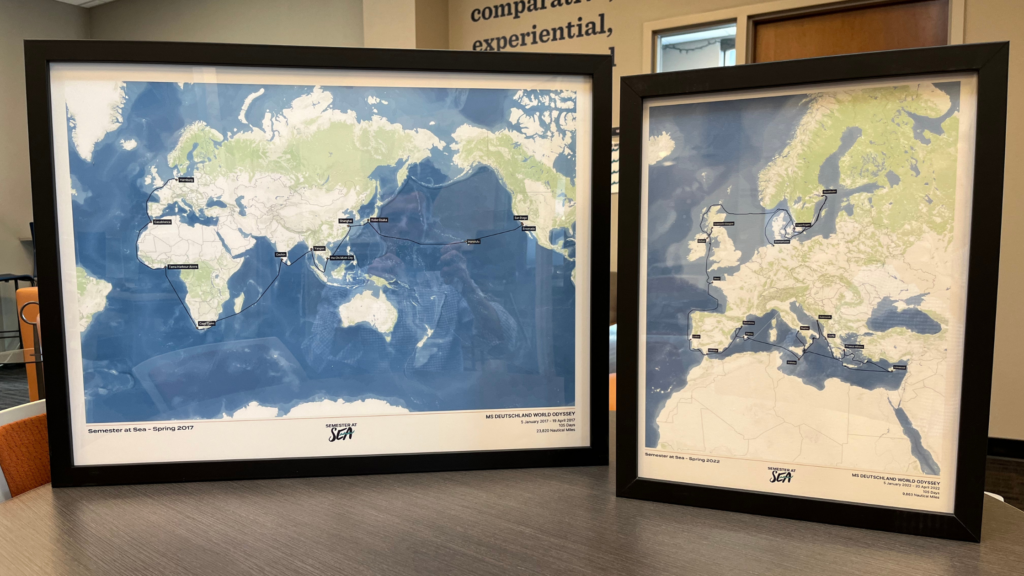Studying abroad is an unforgettable experience that’s impossible to put a price tag on — but for some, that price tag can be a barrier to experiencing it for themselves.
Cost is the most common reason students choose not to study abroad during college or a gap year. The price of a semester abroad varies widely based on the type of program, destination, and what’s included in the experience, but the average cost of a study abroad program is $16,368, according to analysis by Study.com. U.S. colleges that organize their own semesters abroad price them in accordance with their own tuition prices — meaning that there is a broad price range — but third party programs (those not managed by a college or university) range from $15,000 to $22,000.
If these numbers feel like a deterrent, don’t be discouraged! Many college students and study abroad participants use financial aid to defray the overall expense. Some options include taking out loans, applying for scholarships and grants, enrolling in payment plans, and more. It all depends on which part of the program you need help paying for — so let’s break down the cost.
Factors that Affect the Cost of Studying Abroad

Regarding the price of study abroad programs themselves, it makes sense that the costs might seem higher than ever — average U.S. college tuition at four-year schools has risen 173% since 1980. Tuition and fees currently range from about $10,000 for in-state students at public colleges to over $45,000 at private institutions.
All of which is to say, today’s college students and their families understand the price of higher education.
When exploring study abroad programs, it helps to know the factors that contribute to the overall cost in order to make the best and most economical decision for your finances.
- Type of program: Students can study overseas either through their own school’s semester abroad program or with a third-party provider. There is no definitive rule here, but students may find that third party programs cost more than their school’s own offerings, depending on the school they attend. Part of the reason is associated with coordination services — third party programs tend to handle most of the in-country logistics for students, sometimes even providing meals and housing. Price also varies based on the nature of the program — for example, a semester spent on a research vessel in the Pacific Ocean might cost more than a stint on a university campus in Germany.
- Enrollment: Enrolling directly in a foreign university has the potential to cost less than traveling through a U.S.-based school, simply by virtue of lower tuition and cutting out the “coordinator” fee. However, students who choose to attend college in another country likely need to secure their own housing, apply for a student visa, purchase their own medical insurance, and handle all of their own day-to-day expenses.
- Location: On that note, the destination of the study abroad program can have a significant impact on the cost. In general, spending a semester at a public college in a country with a lower cost of living can save a few thousand dollars, compared to studying at a private university in a city known for its high prices. Countries with a strong public education infrastructure can even save students money on tuition.
Other factors to consider include:
- Length of the program
- Travel fees (getting there)
- Type of host educational institution
- Required textbooks and study materials
- Passport and visa fees
- Travel preparations (gear, clothing, equipment, language lessons, etc.)
- Housing
- Meals
- Local transportation
- Incidentals (souvenirs, gifts, school supplies)
- Extracurricular activities
- Insurance
- Health and safety precautions (vaccinations, medication, physicals, etc.)
Primary Cost Drivers of Study Abroad Programs

As you weigh different options for studying abroad, compare the price to the overall value of the experience. Consider what each program offers — a once-in-a-lifetime travel destination, immersive cultural exploration, invaluable preparation for your chosen career field?
However you weigh the cost and benefit, be as realistic as possible about your ability to enjoy your in-country experiences. You may be able to afford tuition and housing, but if that means you won’t have funds left over to visit museums or immerse yourself in the local culture, is that a dealbreaker? It may be tedious, but go through the program fees with a fine-toothed comb to make sure you know exactly what you’re paying for up front and how much you can afford once you’re there.
The following are the primary cost drivers — the “big ticket” items, if you will — in a study abroad program.
Tuition
This is your primary expense in any program. You are, after all, traveling to study, so academics account for a large portion of the bill. Tuition fees vary depending on the program: whether it’s through your own university or a third party, whether it takes place on a campus or further afield, whether it takes place in a country with free public education, and so on. If you’re studying at a foreign university, it also matters whether the school receives funding specifically to host visiting students. Direct enrollment could result in the least expensive tuition, especially in countries with free or low-cost public education like Belgium and Germany (not counting the cost of living).
Accommodation
Housing fees vary widely depending on the program. You could save on accommodations by staying with a host family, or you could shoulder the cost of finding your own apartment or lodging. Many campus-based programs will coordinate student housing for you, but may not include the fee in the overall program cost. Whatever the situation, calculate how much you’ll need in your budget after factoring in accommodations; if roommates are an option, additional housemates will help defray the cost.
Travel Costs
Airfare and other travel costs of getting to your destination are typically not included in program fees. Therefore, you will need to leave room for travel expenses in your overall budget after factoring in tuition, accommodations, and other fees. Your chosen program may be able to recommend affordable flight options, but you may need to do your own research to find the best deals.
When in-country, you will most likely be using public transportation to get around on a day-to-day basis, unless all transportation is provided by your program. Also consider whether you will be traveling recreationally during your stay, using regional railways, bus systems, or flights. Travel insurance can protect you in the case of stolen luggage, canceled flights, or medical care overseas (more on that below).
Cost of Living
It’s easy to forget to budget for incidentals like coffee, dining out, entertainment, and other activities you might be enjoying on a daily or weekly basis. The cost of living varies widely between countries based on their economic status, so research the average price of likely necessities and budget accordingly.
Emergency Funds
In the event of a worst case scenario, such as an injury or illness, medical insurance can make a massive difference when it comes to paying for care. Still, you should know ahead of time the price of a visit to the emergency room or a ride in an ambulance in your host country, should it come to that.
Your program will likely address what to do in the event of an emergency, but it doesn’t hurt to have a tentative plan (and reserve funds) in case you are the victim of theft, become stranded, or encounter any other type of crime in your host country. It’s wise not to carry too much cash on your person, but have at least enough for a cab ride to safety and enough reserve funds to get yourself out of the worst of a tight spot.
Visa and Insurance Costs
If you are attending classes on a foreign campus, you will likely need a student visa. This is a document issued by an embassy or consulate that essentially grants you permission to study in a country other than your own for a specified length of time. Requirements vary by country, but be prepared to spend anywhere from $50–$1,000 USD to apply for a visa; you may also need to visit a consulate or embassy in-person to complete the process. Once overseas, your student visa becomes as important as your passport in confirming your identity and granting you access to the country.
Some third-party programs award academic credit through a U.S.-based institution, in which case a tourist visa is used for international travel instead.
Miscellaneous Costs
This list is potentially endless, since you won’t always know exactly what you’ll be spending your money on overseas until you get there. Think about school-related costs like textbooks, technology, and other study materials; location-specific costs like taxes, service fees and gratuities; and any nice-to-haves, like souvenirs, clothing, and gifts for those at home.
Can You Study Abroad for Free?

It’s very rare that someone gets to participate in a traditional study abroad program for free. Even if they have most of their expenses covered by scholarships or grants, they will likely have to fund some portion of their travels themselves.
However, it is possible to spend a low-cost semester abroad, particularly in countries with a low cost of living or free public education. According to GoOverseas, direct enrollment in a foreign university is the best way to save money on tuition — look to the following countries that provide free or low-cost tuition to students visiting from the U.S.:
- Argentina
- Austria
- Belgium
- Brazil (language dependent)
- Cuba (medical students only)
- Czech Republic (language dependent)
- Denmark
- Estonia
- Finland (language dependent)
- France
- Germany
- Greece (language dependent)
- Iceland
- India
- Iran (government obligation)
- Kenya
- Lebanon
- Luxembourg
- Malta
- Norway
- Panama
- Poland
- Russia (language dependent)
- Slovenia
- Spain
- Sweden
- Taiwan
- Turkey
As you can see, there are many contingencies to free or low-cost tuition, some of which may be prohibitive to international students. Bear in mind that countries with free public education may have a high cost of living, so they may in fact not be the most economical choice. Conditions are always subject to change due to conflicts, political landscape, economic collapse, public health concerns, and more, so note the current state of affairs as you research study abroad destinations.
How to Pay for Study Abroad

If the costs are starting to add up alarmingly, remember that you do not need to pay for your entire study abroad experience out of pocket! There are many ways to defray the cost of studying abroad, including:
- Loans
- Scholarships (for academic performance, interests, goals, demographics, etc.)
- Fellowships
- Grants (federal and private)
- Grant matches
- Work-study jobs
- Student assistance programs
- 529 plans
- Veterans’ benefits
- Payment plans
Be aware that you should never have to pay to secure financial aid! If a scholarship organization charges an application fee or asks for your bank information, report it to the Federal Student Aid Office, then resume your search elsewhere.
If you are having trouble finding a suitable source of funding or don’t know where to start, ask a financial aid advisor at your home school or your chosen program. You can also find creative ways to lower the overall cost, such as:
- Set up a crowdfunding campaign on a site like FundMyTravel.
- Consider a summer program rather than a fall or spring semester, since the program fees tend to be lower.
- If immigration laws allow, you may be able to pick up a part time job in your host country. This can get complicated, however, so be sure you research and complete all the necessary paperwork ahead of time to avoid penalties.
All told, it’s impossible to give a definitive answer on the cost of studying abroad, since there are so many contributing factors. However, if you compare the price of one semester of college in the U.S. to the value of a semester abroad, you may find that any additional expense is worth it for the priceless once-in-a-lifetime experience.
At the Institute for Shipboard Education, we have a wide range of funding solutions for voyagers from all economic situations. Our admissions and financial aid teams are always happy to help future participants identify funding options — send us a message or question today, and we’ll be in touch soon.




